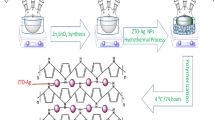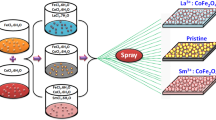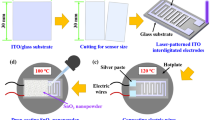Abstract
This study aimed to synthesize Ti3C2Tx (MXene) through selective etching of Ti3AlC2 (MAX) using the in situ hydrofluoric acid method. ZnO was then grown on the Ti3C2Tx surface to form Ti3C2Tx (MXene)/ZnO composites (M-ZnO) using the hydrothermal method. To increase adhesion between the M-ZnO sensing composite and the laser-patterned interdigitated electrode surface, PEDOT:PSS was used as an adhesive layer to obtain PEDOT:PSS/M-ZnO-based gas sensors. The surface morphology, cross-sectional profile, elemental analysis, and structural and chemical compositions of M-ZnO composites were characterized using scanning electron microscope with energy-dispersive X-ray spectroscopy, X-ray diffractometer, X-ray photoelectron spectroscopy, and Fourier transform infrared spectroscopy. The results of the sensing test indicated that the responses of the gas sensors were 3.66%, 6.62%, 8.12%, and 10.23% when PEDOT:PSS/M-ZnO were exposed to 400, 600, 800, and 1000 ppb NO2 concentrations, respectively. The sensitivity of the PEDOT:PSS/ZnO-, PEDOT:PSS/MXene-, and PEDOT:PSS/M-ZnO-based gas sensors was 0.67, 1.37, and 10.61, respectively. The PEDOT:PSS/M-ZnO-based gas sensor had the highest sensitivity of 10.61, which was 15.8 times higher than the PEDOT:PSS/ZnO-based gas sensor. Additionally, the PEDOT:PSS/M-ZnO-based gas sensor displayed good stability and excellent sensing selectivity for NO2 gas at room temperature.









Similar content being viewed by others
Data availability
Not applicable.
Code availability
Not applicable.
References
Chen D, Yu W, Wei L, Ni J, Li H, Chen Y, Tian Y, Yan S, Mei L, Jiao J (2022) High sensitive room temperature NO2 gas sensor based on the avalanche breakdown induced by Schottky junction in TiO2-Sn3O4 nanoheterojunctions. J Alloys Compd 912:165079
Rani S, Kumar M, Sheoran H, Singh R, Singh VN (2022) Rapidly responding room temperature NO2 gas sensor based on SnSe nanostructured film. Mater Today Commun 30:103135
Tseng SF, Chen PS, Hsu SH, Hsiao WT, Peng WJ (2023) Investigation of fiber laser-induced porous graphene electrodes in controlled atmospheres for ZnO nanorod-based NO2 gas sensors. Appl Surf Sci 620:156847
Liu J, Xu Y, Yi F (2022) Fabrication of the ZnO nanowires/TiO2 nanowires/Si micropillars structures for the gas sensor application. Sens Actuators A: Phys 345:113665
Chou CY, Tseng SF, Chang TL, Tu CT, Han HC (2020) Controlled bridge growth of ZnO nanowires on laser-scribed graphene-based devices for NO gas detection. Appl Surf Sci 508:145204
Naguib M, Kurtoglu M, Presser V, Lu J, Niu J, Heon M, Hultman L, Gogotsi Y, Barsoum MW (2011) Two-dimensional nanocrystals produced by exfoliation of Ti3AlC2. Adv Mater 23:4248–4253
Ghidiu M, Lukatskaya MR, Zhao MQ, Gogotsi Y, Barsoum MW (2014) Conductive two-dimensional titanium carbide ‘clay’ with high volumetric capacitance. Nature 516:78–81
Wang L, Zhang H, Wang B, Shen C, Zhang C, Hu Q, Zhou A, Liu B (2016) Synthesis and electrochemical performance of Ti3C2Tx with hydrothermal process. Electron Mater Lett 12:702–710
Urbankowski P, Anasori B, Hantanasirisakul K, Yang L, Zhang L, Haines B, May ST, Billinge SJL, Gogotsi Y (2017) 2D molybdenum and vanadium nitrides synthesized by ammoniation of 2D transition metal carbides (MXenes). Nanoscale 9:17722–17730
Shuck CE, Sarycheva A, Anayee M, Levitt A, Zhu Y, Uzun S, Balitskiy V, Zahorodna V, Gogotsi O, Gogotsi Y (2020) Scalable synthesis of Ti3C2Tx MXene. Adv Eng Mater 22:1901241
Alwarappan S, Nesakumar N, Sun D, Hu TY, Li CZ (2022) 2D metal carbides and nitrides (MXenes) for sensors and biosensors. Biosens Bioelectron 205:113943
Noh S, Lee H, Kim J, Jang H, An J, Park C, Lee MH, Lee T (2022) Rapid electrochemical dual-target biosensor composed of an Aptamer/MXene hybrid on Au microgap electrodes for cytokines detection. Biosens Bioelectron 207:114159
Zhang X, Zhang W, Zhao H (2022) Ultrasound-assisted fabrication of Ti3C2Tx MXene toward enhanced energy storage performance. Ultrason Sonochem 86:106024
Jia B, Zhao Z, Wu X, Luo C, Wang Y, Chen W (2022) Energy storage mechanism of MXene-Based sodium/potassium titanate for high performance electrode. Ceram Int 48:12875–12883
Li L, Cheng Y, Cao H, Liang Z, Liu Z, Yan S, Li L, Jia S, Wang J, Gao Y (2022) MXene/rGO/PS spheres multiple physical networks as high-performance pressure sensor. Nano Energy 95:106986
He J, Shi F, Liu Q, Pang Y, He D, Sun W, Peng L, Yang J, Qu M (2022) Wearable superhydrophobic PPy/MXene pressure sensor based on cotton fabric with superior sensitivity for human detection and information transmission. Colloids Surf A: Physicochem Eng Asp 642:128676
Choi J, Kim YJ, Cho SY, Park K, Kang H, Kim SJ, Jung HT (2020) In situ formation of multiple schottky barriers in a Ti3C2 MXene film and its application in highly sensitive gas sensors. Adv Funct Mater 30:2003998
Xia Q, Fan Y, Li S, Zhou A, Shinde N, Mane RS (2023) MXene-based chemical gas sensors: Recent developments and challenges. Diam Relat Mater 131:109557
Hu C, Yu X, Li Y, Cheng J, Li Q, Xiao B (2022) Bandgap engineering of strained S-terminated MXene and its promising application as NOx gas sensor. Appl Surf Sci 592:153296
He T, Liu W, Lv T, Ma M, Liu Z, Vasiliev A, Li X (2021) MXene/SnO2 heterojunction based chemical gas sensors. Sens Actuators B: Chem 329:129275
Huang C, Luo Q, Miao Q, He Z, Fan P, Chen Y, Zhang Q, He X, Li L, Liu X (2022) MXene-based double-network organohydrogel with excellent stretchability, high toughness, anti-drying and wide sensing linearity for strain sensor. Polymer 253:124993
Taromsari SM, Shi HH, Saadatnia Z, Park CB, Naguib HE (2022) Design and development of ultra-sensitive, dynamically stable, multi-modal GnP@MXene nanohybrid electrospun strain sensors. Chem Eng J 442:136138
Xu B, Zhu M, Zhang W, Zhen X, Pei Z, Xue Q, Zhi C, Shi P (2016) Ultrathin MXene-micropattern-based field-effect transistor for probing neural activity. Adv Mater 23:3333–3339
Tai H, Duan Z, He Z, Li X, Xu J, Liu B, Jiang Y (2019) Enhanced ammonia response of Ti3C2Tx nanosheets supported by TiO2 nanoparticles at room temperature. Sens Actuators B Chem 298:126874
Yang Z, Jiang L, Wang J, Liu F, He J, Liu A, Lv S, You R, Yan X, Sun P (2021) Flexible resistive NO2 gas sensor of three-dimensional crumpled MXene Ti3C2Tx/ZnO spheres for room temperature application. Sens Actuators B Chem 326:128828
Liu Z, He T, Sun H, Huang B, Li X (2022) Layered MXene heterostructured with In2O3 nanoparticles for ammonia sensors at room temperature. Sens Actuators B Chem 365:131918
Sun S, Wang M, Chang X, Jiang Y, Zhang D, Wang D, Zhang Y, Lei Y (2020) W18O49/Ti3C2Tx Mxene nanocomposites for highly sensitive acetone gas sensor with low detection limit. Sens Actuators B Chem 304:127274
Hermawan A, Zhang B, Taufik A, Asakura Y, Hasegawa T, Zhu J, Shi P, Yin S (2020) CuO nanoparticles/Ti3C2Tx MXene hybrid nanocomposites for detection of toluene gas. ACS Appl Nano Mater 3:4755–4766
Gasso S, Sohal MK, Mahajan A (2022) MXene modulated SnO2 gas sensor for ultra-responsive room-temperature detection of NO2. Sens Actuators B Chem 357:131427
Wang J, Yang Y, Xia Y (2022) Mesoporous MXene/ZnO nanorod hybrids of high surface area for UV-activated NO2 gas sensing in ppb-level. Sens Actuators B Chem 353:131087
Liu F, Zhou A, Chen J, Jia J, Zhou W, Wang L, Hu Q (2017) Preparation of Ti3C2 and Ti2C MXenes by fluoride salts etching and methane adsorptive properties. Appl Surf Sci 416:781–789
Thongam DD, Gupta J, Sahu NK (2019) Effect of induced defects on the properties of ZnO nanocrystals: surfactant role and spectroscopic analysis. SN Appl Sci 1:1–14
Liu G, Liu S, Ma K, Wang H, Wang X, Liu G, Jin W (2020) Polyelectrolyte functionalized Ti2CTx mxene membranes for pervaporation dehydration of isopropanol/water mixtures. Ind Eng Chem Res 59:4732–4741
Chen J, Yuan X, Lyu F, Zhong Q, Hu H, Pan Q, Zhang Q (2019) Integrating MXene nanosheets with cobalt-tipped carbon nanotubes for an efficient oxygen reduction reaction. J Mater Chem A 7:1281–1286
Liu M, Li J, Bian R, Wang X, Ji Y, Zhang X, Tian J, Shi F, Cui H (2022) ZnO@Ti3C2 MXene interfacial Schottky junction for boosting spatial charge separation in photocatalytic degradation. J Alloys Compd 905:164025
Tseng SF, Liao CH (2020) Investigation of interactions between ultrafast laser beams and screen-printed silver nanopaste films. Appl Surf Sci 512:144696
Mane A, Kulkarni S, Navale S, Ghanwat A, Shinde N, Kim J, Patil V (2014) NO2 sensing properties of nanostructured tungsten oxide thin films. Ceram Int 40:16495–16502
Lee KS, Shim J, Lee JS, Lee J, Moon HG, Park YJ, Park D, Son DI (2022) Adsorption behavior of NO2 molecules in ZnO-mono/multilayer graphene core–shell quantum dots for NO2 gas sensor. J Ind Eng Chem 106:279–286
Liu S, Yu B, Zhang H, Fei T, Zhang T (2014) Enhancing NO2 gas sensing performances at room temperature based on reduced graphene oxide-ZnO nanoparticles hybrids. Sens Actuators B Chem 202:272–278
Vanalakar SA, Gang MG, Patil VL, Dongale TD, Patil PS, Kim JH (2018) Enhanced gas-sensing response of zinc oxide nanorods synthesized via hydrothermal route for nitrogen dioxide gas. J Electron Mater 48:589–595
Ying S, Wang Y, Wu Z, Huang M, Dong L, Zhao J, Peng C (2021) Highly-sensitive NO2 gas sensors based on three-dimensional nanotube graphene and ZnO nanospheres nanocomposite at room temperature. Appl Surf Sci 566:150720
Qiu J, Xia X, Hu Z, Zhou S, Wang Y, Wang Y, Zhang R, Li J, Zhou Y (2022) Molecular ammonia sensing of PEDOTPSS/nitrogen doped MXene Ti3C2Tx composite film at room temperature. Nanotechnology 33:065501
Han TH, Bak SY, Kim S, Lee SH, Han YJ, Yi M (2021) Decoration of CuO NWs gas sensor with ZnO NPs for improving NO2 sensing characteristics. Sensors 21(6):2103
Funding
This study was funded by the National Taipei University of Technology—Thammasat University Joint Research Program (contract nos. NTUT-TU-110–01 and MF 2/2566) and National Science and Technology Council of Taiwan (contract nos. MOST 111–2628-E-027–005-MY2 and NSTC 111–2622-E-027–015). The performance measurement system of the gas sensors was supported by the Taiwan Instrument Research Institute, National Applied Research Laboratories, Taiwan.
Author information
Authors and Affiliations
Contributions
Shih-Feng Tseng: conceptualization; investigation; methodology; project administration; formal analysis; writing — original draft; writing—reviewing and editing. Yi-Hao Lin: data curation; software; investigation; validation. Meng-Huan Zhou: data curation; software; validation. Shu-Han Hsu: conceptualization; methodology; formal analysis. Wen-Tse Hsiao: investigation; software; validation.
Corresponding authors
Ethics declarations
Ethics approval
Not applicable.
Consent to participate
Not applicable.
Consent for publication
Not applicable.
Conflict of interest
The authors declare no competing interests.
Additional information
Publisher's note
Springer Nature remains neutral with regard to jurisdictional claims in published maps and institutional affiliations.
Supplementary Information
Below is the link to the electronic supplementary material.
Rights and permissions
Springer Nature or its licensor (e.g. a society or other partner) holds exclusive rights to this article under a publishing agreement with the author(s) or other rightsholder(s); author self-archiving of the accepted manuscript version of this article is solely governed by the terms of such publishing agreement and applicable law.
About this article
Cite this article
Tseng, SF., Lin, YH., Zhou, MH. et al. Synthesis of Ti3C2Tx/ZnO composites decorated with PEDOT:PSS for NO2 gas sensors. Int J Adv Manuf Technol 126, 2269–2281 (2023). https://doi.org/10.1007/s00170-023-11285-5
Received:
Accepted:
Published:
Issue Date:
DOI: https://doi.org/10.1007/s00170-023-11285-5




